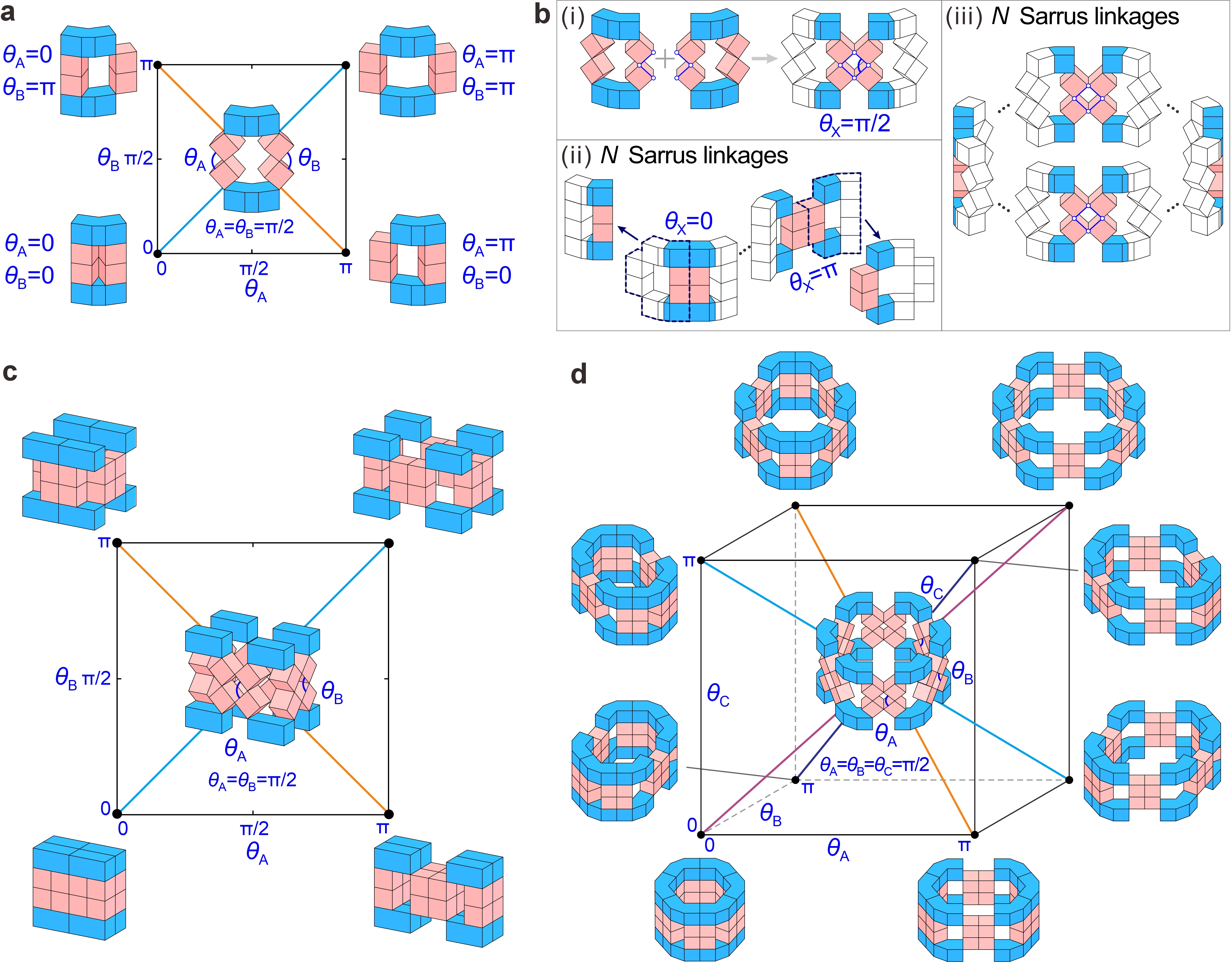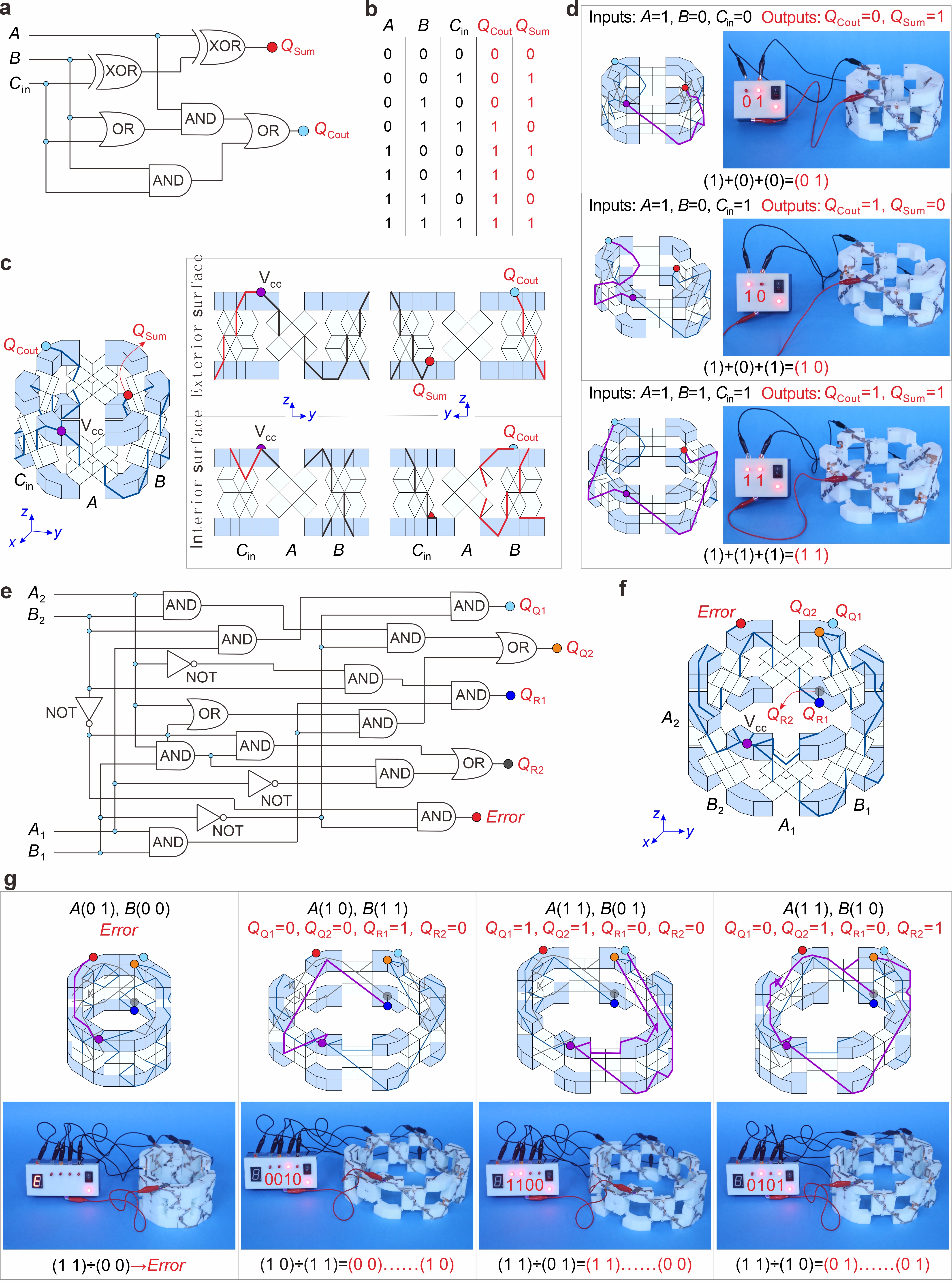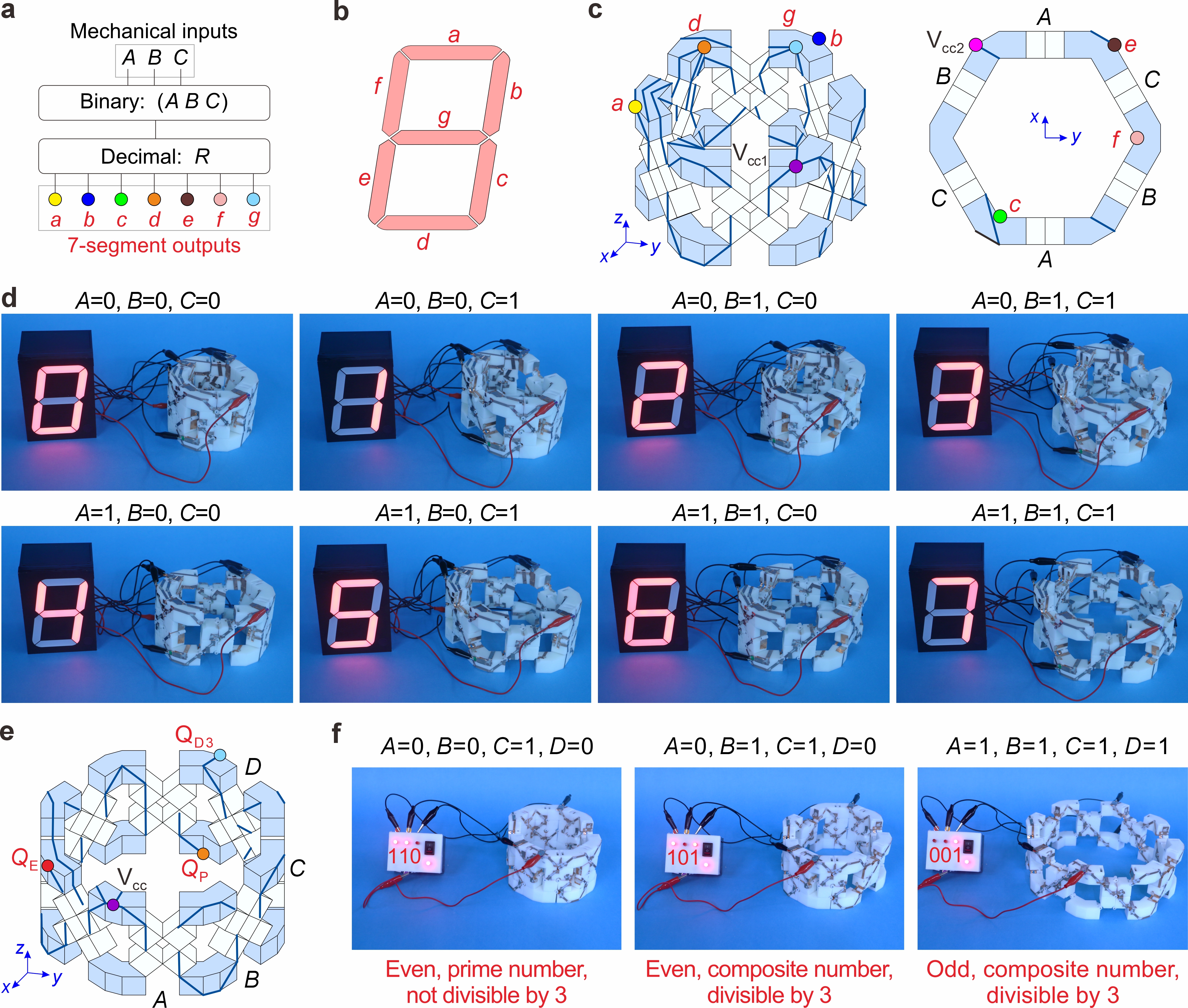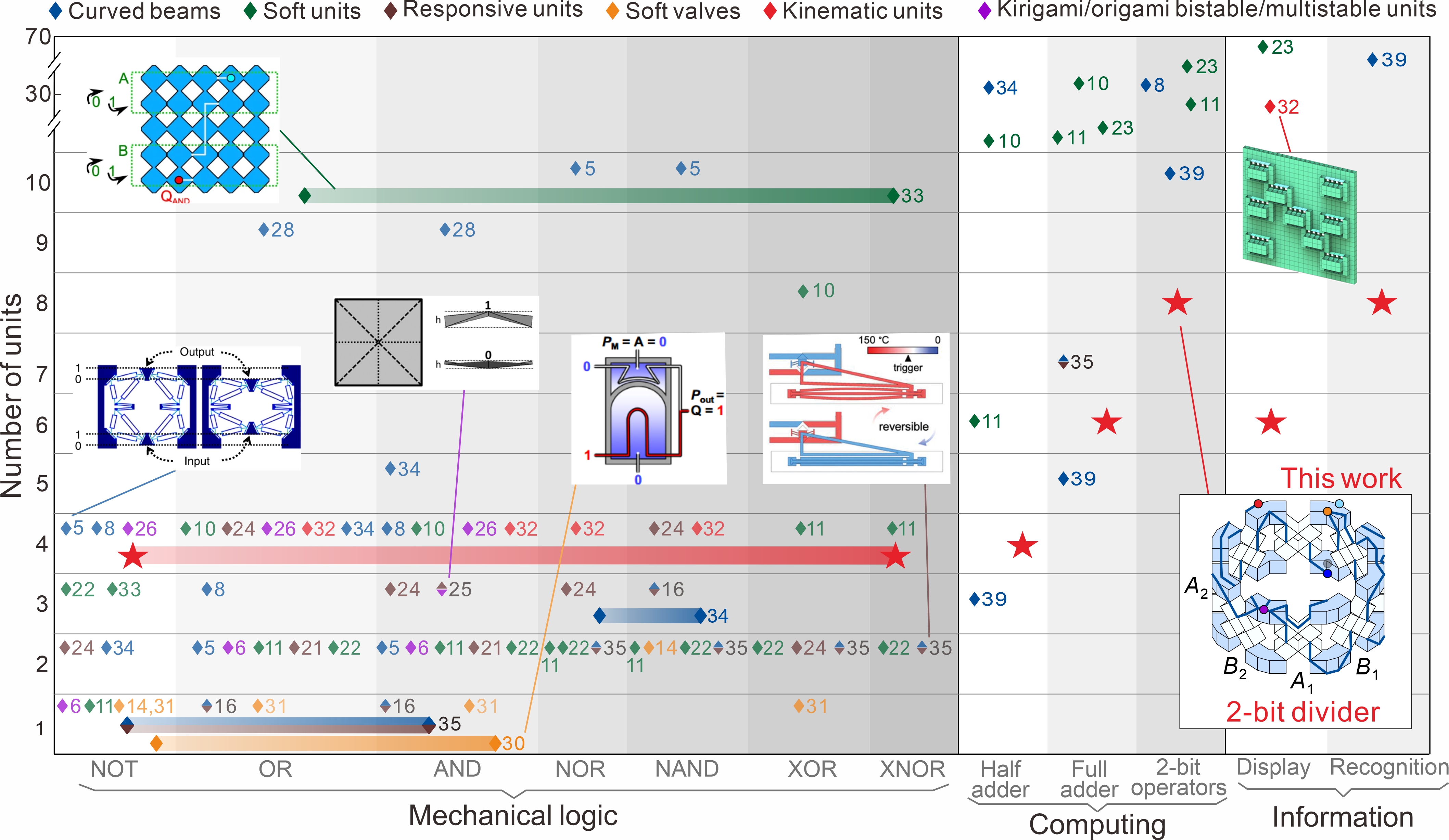Research
Team
Publications
News
|
New Publication: Advanced Science | Kaili Xi published A kinematically Bifurcated Metamaterial for Integrated Logic Operation and Computing
From: Date: 2025-07-21 Overview Mechanical computing metamaterials, which utilize transitions among discrete configurations to process information autonomously when perceiving external stimuli, are important in the development of intelligent mechanical systems. However, most current designs involve tessellations of planar mechanisms or bistable structures, which typically offer only two distinct configurations, requiring many units to provide multiple input-outputs for complex logic operations with little consideration of system integration. To this end, a research team of Professor Yan Chen from the School of Mechanical Engineering at Tianjin University, in cooperation with Professor Zhong You from University of Oxford and Professor Changqing Chen from Tsinghua University proposed a family of 2n-side kinematic polygonal modules introducing n decoupled inputs and 2ⁿ transitable extreme configurations. They first designed and integrated seven basic logic gates on a quadrilateral module, followed by developing a minimized combinatorial logic canonical function, the parallel computing sum of the product (PCSoP) function, to simplify the construction of logic computing systems. On this basis, all four types of arithmetic operations (a 2-bit divider is implemented for the first time), information display and recognition were realized on a single polygonal module. The research, titled "A kinematically Bifurcated Metamaterial for Integrated Logic Operation and Computing", was published online in Advanced Science on 17 July 2025. Co-corresponding authors are Prof. Yan Chen and Associate Researcher Xiao Zhang; the first author is Ph.D. student Kaili Xi, with experimental support from M.S. student Jingsong Wei and guidance from Prof. Jiayao Ma, Prof. Zhong You, and Prof. Changqing Chen. The research was supported by the National Natural Science Foundation of China and the Tencent Foundation (XPLORER PRIZE). Highlight Starting from the kinematic bifurcation of Sarrus linkages (Fig. 1a), researchers link multiple Sarrus linkages via 4-bar linkages (Fig. 1b(iii)) into a closed-loop metamaterial, thereby creating a family of single-DOF, 2n-sided polygonal modules. These modules can accept n decoupled mechanical inputs and switch among 2ⁿ extreme configurations (dihedral angles θX=0 or π). The mechanical bit is defined as follows: when θX=0, the mechanical bit input X=0 corresponds to the configuration where the top and bottom blue blocks are closed; when θX=π, X=1, and the blue blocks are separated. For two mechanical bit inputs (A, B) to the quadrilateral module, four combinations corresponding to four distinct configurations can be realized: (0, 0), (0, 1), (1, 0), and (1, 1) (Fig. 1c). When 2n= 6, the hexagonal module has eight (23) configurations with three decoupled inputs (Fig. 1d). Similarly, when 2n=8, the octagonal module has 23 configurations with four decoupled inputs. This design provides a wide range of configurations for binary-state mechanical computing, enabling individual modules to perform complex logic operations and information processing tasks. Fig. 1 Construction and kinematic bifurcation of polygonal modules Next, researchers couple these polygonal modules with electrical circuits to construct a set of conductive logic modules for various logic operations. As shown in Fig. 2, taking the quadrilateral module as an example, they cleverly arrange circuits on its surfaces to realize the basic Buffer and NOT gates, and further implement OR, NOR, AND, NAND, XOR and XNOR gates by connecting Buffer and/or NOT gates in series or parallel. Further, by sharing switches (Buffer and NOT gates) and module surfaces, seven basic logic gates are integrated within a single quadrilateral module (Fig. 2d). By selectively engaging input and output nodes corresponding to different logic gates, the integrated module executes all seven basic logic gates (Movie 1). Fig. 2 Design, integration, and experiments with the logic quadrilateral module
Movie 1 The quadrilateral logic module integrating seven basic logic gates In addition to logic gates, polygonal modules can perform combinatorial logic operations such as arithmetic operations. Researchers first design and implement a half-adder/subtractor on a quadrilateral module (Movie 2). Subsequently, a hexagonal module, with three decoupled mechanical inputs, is used to realize a full adder (Fig. 3a-d, Movie 3). Owing to the PCSoP function, which extracts duplicate mechanical logic network components as a single sub-task, the designed full adder employs only 15 switches, less than the number of switches included in full adders developed using the SSoP functions (24 switches) and QMSoP functions (18 switches). Likewise, researchers implement 2-bit adders, subtractors, and multipliers (Movie 4) on an octagonal module. By introducing an Error output for divide-by-zero cases, they construct the first 2-bit divider (Fig. 3e–g, Movie 5). These designs fully demonstrate the brevity and high computational utility of polygonal modules developed using the PCSoP function.
Movie 2 The half adder/subtractor on a quadrilateral module Fig. 3 Arithmetic operators implemented on polygonal modules
Movie 3 The full adder on a hexagonal module
Movie 4 The 2-bit multiplier on an octagonal module
Movie 5 The 2-bit divider on an octagonal module In addition to mechanical logic and computing, polygonal modules can facilitate diverse applications, such as displaying and recognizing information (Fig. 4). For instance, the hexagonal module serves as a binary-coded decimal (BCD) to 7-segment display decoder, which converts a binary number (A B C) into a decimal number R (0-7) and provides electrical outputs a-g to drive 7-segment LEDs to display the corresponding R (Movie 6). Moreover, an octagonal module is utilized to construct a recognition module that can simultaneously evaluate three common mathematical properties of the generated decimal numbers R (2~15) and assesses their parity, primality and divisibility by 3 (Movie 7). Other properties with known input-output relationships can also be analyzed by constructing the corresponding recognition modules. Fig. 4 Information display and recognition functions implemented on polygonal
Movie 6 The binary-coded decimal to 7-segment display decoder on a hexagonal module
Movie 7 The recognition module for binary-coded decimal numbers 2-15 on an octagonal module Finally, researchers compare this work with existing studies in mechanical logic, mechanical computing, information display and information recognition, as summarized in Fig. 5. The results show that the polygonal logic modules require significantly fewer units to achieve the same functions. For example, this work requires only a 4-unit quadrilateral module to simultaneously implement all seven basic gates which requires much fewer units than the other works. In addition, the polygonal module-based logical operators, with fewer units, match or exceed the functionality of existing designs. Fig. 5 Comparison of the number of units used in mechanical logic, mechanical computing, information display and information recognition applications between our work and prior studies To summarize, this research proposes a family of kinematically bifurcated polygonal modules that, coupled with electrical circuits, implement all four types of 2-bit arithmetic operations (a 2-bit divider is implemented for the first time), information display and recognition within a single polygonal module. Guided by the PCSoP functions, this research significantly reduces the number of switches and units required, achieving an unprecedented level of system integration in mechanical computing.
Kaili Xi, Jingsong Wei, Xiao Zhang*, Jiayao Ma, Zhong You, Changqing Chen, Yan Chen*. A kinematically Bifurcated Metamaterial for Integrated Logic Operation and Computing, Advanced Science, 2025, e09829. |





